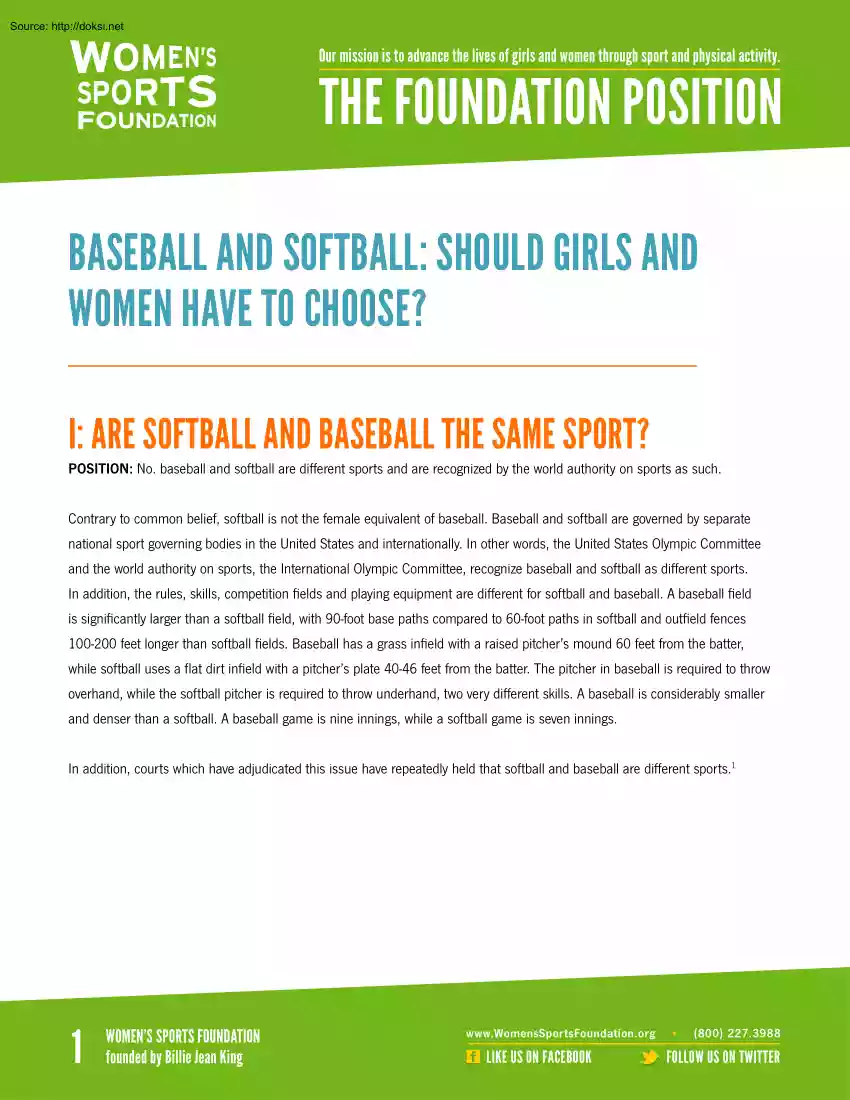A doksi online olvasásához kérlek jelentkezz be!

A doksi online olvasásához kérlek jelentkezz be!
Nincs még értékelés. Legyél Te az első!
Mit olvastak a többiek, ha ezzel végeztek?
Tartalmi kivonat
Source: http://doksi.net Our mission is to advance the lives of girls and women through sport and physical activity. THE FOUNDATION POSITION BASEBALL AND SOFTBALL: SHOULD GIRLS AND WOMEN HAVE TO CHOOSE? I: ARE SOFTBALL AND BASEBALL THE SAME SPORT? POSITION: No. baseball and softball are different sports and are recognized by the world authority on sports as such Contrary to common belief, softball is not the female equivalent of baseball. Baseball and softball are governed by separate national sport governing bodies in the United States and internationally. In other words, the United States Olympic Committee and the world authority on sports, the International Olympic Committee, recognize baseball and softball as different sports. In addition, the rules, skills, competition fields and playing equipment are different for softball and baseball. A baseball field is significantly larger than a softball field, with 90-foot base paths compared to 60-foot paths in softball and outfield
fences 100-200 feet longer than softball fields. Baseball has a grass infield with a raised pitcher’s mound 60 feet from the batter, while softball uses a flat dirt infield with a pitcher’s plate 40-46 feet from the batter. The pitcher in baseball is required to throw overhand, while the softball pitcher is required to throw underhand, two very different skills. A baseball is considerably smaller and denser than a softball. A baseball game is nine innings, while a softball game is seven innings In addition, courts which have adjudicated this issue have repeatedly held that softball and baseball are different sports.1 1 WOMEN’S SPORTS FOUNDATION founded by Billie Jean King www.WomensSportsFoundationorg LIKE US ON FACEBOOK • (800) 227.3988 FOLLOW US ON TWITTER Source: http://doksi.net II: DOES TITLE IX, THE FEDERAL LAW PROHIBITING SEX DISCRIMINATION IN EDUCATIONAL PROGRAMS AND ACTIVITIES OFFERED BY INSTITUTIONS RECEIVING FEDERAL FUNDS, REQUIRE THAT WOMEN BE PERMITTED TO
PLAY BASEBALL? POSITION: Yes. In non-contact sports, Title IX requires that members of the underrepresented gender be permitted to play on teams provided for the overrepresented gender or that separate teams in that sport be created for underrepresented gender. In other words, if a school has a men’s baseball team and women are underrepresented in the overall athletic program, women must be permitted to try out for the men’s baseball team or the school must create a separate baseball team for women. A school does not have to allow a woman to try out under Title IX for the men’s baseball team if the percentage of female athletes in the overall athletic program is proportional to percentage of females in the general student body (meaning if women comprise 49% of the student body, they also comprise 49% of the athletes.) because in that case, women would not be underrepresented Also, the exclusion of females from participation in baseball when it is solely offered to males has been
held to violate the Equal Protection Clause of the 14th Amendment of the United States Constitution.2 III: CAN WOMEN COMPETE WITH AND AGAINST MEN IN BASEBALL? POSITION: Yes, there are many women who have the skills and physical abilities to compete on men’s teams in baseball. Baseball is not an “absolute strength” sport. Baseball is a game involving skills that are a combination of timing, coordination, strength, knowledge of the game, strategies, control and savvy, to say nothing of the importance of competitiveness and desire. Even though strength may be a factor in pitching and hitting, timing and coordination can produce comparable throwing and bat 2 WOMEN’S SPORTS FOUNDATION founded by Billie Jean King www.WomensSportsFoundationorg LIKE US ON FACEBOOK • (800) 227.3988 FOLLOW US ON TWITTER Source: http://doksi.net speed. Bat speed and bat control are more important than absolute strength There are plenty of examples in baseball of the smaller but skilled player
who overcomes disadvantages of foot speed, size or strength to be an exceptional player. Even when strength is a consideration, the relative strength and size of men and women is not a prohibitive factor. Physiological differences within the sexes are greater than the differences between the sexes. Thus, especially in sport leagues below the most elite level of sports participation, some individual girls will be able to compete with and against boys, despite the physiological advantages of most boys. IV. SHOULD GIRLS AND WOMEN BE ENCOURAGED TO PLAY IN “NONTRADITIONAL” SPORTS FOR WOMEN? POSITION: Women are no longer limited by societal perceptions of “appropriate” activities for females. Women should be permitted and encouraged to participate in any sport. Stereotypical views of “appropriate” sports for women have limited participation opportunities for girls and women throughout history. Women were not permitted to run distances greater than 400 meters in the Olympic Games
until the 1950s and were not permitted to run the Olympic marathon until 1984 because of stereotypical perceptions of women’s abilities to run distances. Expectations of “feminine” behavior precluded many women from lifting weights, playing football or competing as wrestlers. Yet, there are more than 6,000 women competing in high school football and wrestling today, and 1,300-plus women play high school baseball. Pole vaulting and weight lifting have become popular women’s sports, women’s ice hockey has been an Olympic sport since 1998, and there are now women’s professional football leagues and a women’s national baseball team. V: IF WOMEN PARTICIPATE IN BASEBALL, SHOULD MEN BE PERMITTED TO PARTICIPATE IN SOFTBALL? POSITION: Men should be allowed to play on a softball teams when there is no team for men offered, men are underrepresented with regard to total athletic opportunities and the strength and skill levels of the men are comparable. 3 WOMEN’S SPORTS
FOUNDATION founded by Billie Jean King www.WomensSportsFoundationorg LIKE US ON FACEBOOK • (800) 227.3988 FOLLOW US ON TWITTER Source: http://doksi.net Since the opportunities for men have not been historically limited and men are typically overrepresented in athletic departments, men do not have the same rights to compete on women’s teams as women do on men’s teams. While some courts in Equal Rights Amendment states have found that such a position violates the individual rights of men,3 other courts in Equal Rights Amendment states4 and federal courts supporting 14th Amendment protections have found that protecting the participation rights of women as a previously discriminated against “class” outweigh the rights of an “individual” man to play on a women’s team.5 When members of the overrepresented gender (usually males), are permitted to play on teams for the underrepresented gender (usually women), they further diminish opportunities for the underrepresented
gender. Acknowledgements The Women’s Sports Foundation thanks John Kovach, Chairperson, United States Girls Baseball Association; Terri Lakowski, Women’s Sports Foundation Public Policy Director; Dr. Donna Lopiano, former Women’s Sports Foundation Chief Executive Officer; and Dr Marj Snyder, Women’s Sports Foundation Chief Programs and Planning Officer, for their assistance in creating this document. Endnotes 1 Israel v. West Virginia Secondary Schools Activities Commission, 388 SE2d 480 (WVa 1989) (holding that softball and baseball are different sports; therefore, preventing a girl from playing on the boys’ team violated the 14th Amendment Equal Protection Clause and the girl must be allowed to try out for the baseball team.) 2 Id. 3 Attorney General v. Massachusetts Interscholastic Athletic Association, Inc, 393 N E 2d 284 (Mass 1979) (rejecting an interscholastic league policy forbidding males to participate in females’ sports teams, but permitting females to
participate in males’ teams. The court found that if females were permitted to participate in male sports teams for which there was no corresponding female team, then males must also be permitted to participate in female teams for which there is no corresponding male team.) Comment per Farina, Elizabeth (2005) Unpublished manuscript prepared for Professor Deborah Brake, University of Pittsburgh, dated August 11, 2005. 4 B.C v Board of Education, Cumberland Regional School District, 531 A 2d 1059 (NJ Super 1987) (holding that preserving women’s athletic opportunities was an important governmental objective and that prohibiting males from participating in female’s teams, like field hockey, was substantially related to that objective.) Petrie v Illinois High School Association, 394 N E 2d 855 (Ill App Ct 1979) (upholding a policy restricting membership on the school’s only volleyball team to females.) Comment per Farina, Elizabeth (2005) Unpublished manuscript prepared for
Professor Deborah Brake, University of Pittsburgh, dated August 11, 2005. 5 Clark v. Arizona Interscholastic Association, 695 F 2d 1126 (Ariz 1982) (holding that excluding males from participating on the female volleyball team did not violate Equal Protection rights of the male students because it was a substantially related method of achieving the important objectives of promoting sport opportunities for females and redressing past discrimination.) Mularadelis v Haldane Central School Board, 74 AD 2d 248 (NY App Div 1980) (upholding the exclusion of male from female sports team) Comment per Farina, Elizabeth. (2005) Unpublished manuscript prepared for Professor Deborah Brake, University of Pittsburgh, dated August 11, 2005. 4 WOMEN’S SPORTS FOUNDATION founded by Billie Jean King www.WomensSportsFoundationorg LIKE US ON FACEBOOK • (800) 227.3988 FOLLOW US ON TWITTER
fences 100-200 feet longer than softball fields. Baseball has a grass infield with a raised pitcher’s mound 60 feet from the batter, while softball uses a flat dirt infield with a pitcher’s plate 40-46 feet from the batter. The pitcher in baseball is required to throw overhand, while the softball pitcher is required to throw underhand, two very different skills. A baseball is considerably smaller and denser than a softball. A baseball game is nine innings, while a softball game is seven innings In addition, courts which have adjudicated this issue have repeatedly held that softball and baseball are different sports.1 1 WOMEN’S SPORTS FOUNDATION founded by Billie Jean King www.WomensSportsFoundationorg LIKE US ON FACEBOOK • (800) 227.3988 FOLLOW US ON TWITTER Source: http://doksi.net II: DOES TITLE IX, THE FEDERAL LAW PROHIBITING SEX DISCRIMINATION IN EDUCATIONAL PROGRAMS AND ACTIVITIES OFFERED BY INSTITUTIONS RECEIVING FEDERAL FUNDS, REQUIRE THAT WOMEN BE PERMITTED TO
PLAY BASEBALL? POSITION: Yes. In non-contact sports, Title IX requires that members of the underrepresented gender be permitted to play on teams provided for the overrepresented gender or that separate teams in that sport be created for underrepresented gender. In other words, if a school has a men’s baseball team and women are underrepresented in the overall athletic program, women must be permitted to try out for the men’s baseball team or the school must create a separate baseball team for women. A school does not have to allow a woman to try out under Title IX for the men’s baseball team if the percentage of female athletes in the overall athletic program is proportional to percentage of females in the general student body (meaning if women comprise 49% of the student body, they also comprise 49% of the athletes.) because in that case, women would not be underrepresented Also, the exclusion of females from participation in baseball when it is solely offered to males has been
held to violate the Equal Protection Clause of the 14th Amendment of the United States Constitution.2 III: CAN WOMEN COMPETE WITH AND AGAINST MEN IN BASEBALL? POSITION: Yes, there are many women who have the skills and physical abilities to compete on men’s teams in baseball. Baseball is not an “absolute strength” sport. Baseball is a game involving skills that are a combination of timing, coordination, strength, knowledge of the game, strategies, control and savvy, to say nothing of the importance of competitiveness and desire. Even though strength may be a factor in pitching and hitting, timing and coordination can produce comparable throwing and bat 2 WOMEN’S SPORTS FOUNDATION founded by Billie Jean King www.WomensSportsFoundationorg LIKE US ON FACEBOOK • (800) 227.3988 FOLLOW US ON TWITTER Source: http://doksi.net speed. Bat speed and bat control are more important than absolute strength There are plenty of examples in baseball of the smaller but skilled player
who overcomes disadvantages of foot speed, size or strength to be an exceptional player. Even when strength is a consideration, the relative strength and size of men and women is not a prohibitive factor. Physiological differences within the sexes are greater than the differences between the sexes. Thus, especially in sport leagues below the most elite level of sports participation, some individual girls will be able to compete with and against boys, despite the physiological advantages of most boys. IV. SHOULD GIRLS AND WOMEN BE ENCOURAGED TO PLAY IN “NONTRADITIONAL” SPORTS FOR WOMEN? POSITION: Women are no longer limited by societal perceptions of “appropriate” activities for females. Women should be permitted and encouraged to participate in any sport. Stereotypical views of “appropriate” sports for women have limited participation opportunities for girls and women throughout history. Women were not permitted to run distances greater than 400 meters in the Olympic Games
until the 1950s and were not permitted to run the Olympic marathon until 1984 because of stereotypical perceptions of women’s abilities to run distances. Expectations of “feminine” behavior precluded many women from lifting weights, playing football or competing as wrestlers. Yet, there are more than 6,000 women competing in high school football and wrestling today, and 1,300-plus women play high school baseball. Pole vaulting and weight lifting have become popular women’s sports, women’s ice hockey has been an Olympic sport since 1998, and there are now women’s professional football leagues and a women’s national baseball team. V: IF WOMEN PARTICIPATE IN BASEBALL, SHOULD MEN BE PERMITTED TO PARTICIPATE IN SOFTBALL? POSITION: Men should be allowed to play on a softball teams when there is no team for men offered, men are underrepresented with regard to total athletic opportunities and the strength and skill levels of the men are comparable. 3 WOMEN’S SPORTS
FOUNDATION founded by Billie Jean King www.WomensSportsFoundationorg LIKE US ON FACEBOOK • (800) 227.3988 FOLLOW US ON TWITTER Source: http://doksi.net Since the opportunities for men have not been historically limited and men are typically overrepresented in athletic departments, men do not have the same rights to compete on women’s teams as women do on men’s teams. While some courts in Equal Rights Amendment states have found that such a position violates the individual rights of men,3 other courts in Equal Rights Amendment states4 and federal courts supporting 14th Amendment protections have found that protecting the participation rights of women as a previously discriminated against “class” outweigh the rights of an “individual” man to play on a women’s team.5 When members of the overrepresented gender (usually males), are permitted to play on teams for the underrepresented gender (usually women), they further diminish opportunities for the underrepresented
gender. Acknowledgements The Women’s Sports Foundation thanks John Kovach, Chairperson, United States Girls Baseball Association; Terri Lakowski, Women’s Sports Foundation Public Policy Director; Dr. Donna Lopiano, former Women’s Sports Foundation Chief Executive Officer; and Dr Marj Snyder, Women’s Sports Foundation Chief Programs and Planning Officer, for their assistance in creating this document. Endnotes 1 Israel v. West Virginia Secondary Schools Activities Commission, 388 SE2d 480 (WVa 1989) (holding that softball and baseball are different sports; therefore, preventing a girl from playing on the boys’ team violated the 14th Amendment Equal Protection Clause and the girl must be allowed to try out for the baseball team.) 2 Id. 3 Attorney General v. Massachusetts Interscholastic Athletic Association, Inc, 393 N E 2d 284 (Mass 1979) (rejecting an interscholastic league policy forbidding males to participate in females’ sports teams, but permitting females to
participate in males’ teams. The court found that if females were permitted to participate in male sports teams for which there was no corresponding female team, then males must also be permitted to participate in female teams for which there is no corresponding male team.) Comment per Farina, Elizabeth (2005) Unpublished manuscript prepared for Professor Deborah Brake, University of Pittsburgh, dated August 11, 2005. 4 B.C v Board of Education, Cumberland Regional School District, 531 A 2d 1059 (NJ Super 1987) (holding that preserving women’s athletic opportunities was an important governmental objective and that prohibiting males from participating in female’s teams, like field hockey, was substantially related to that objective.) Petrie v Illinois High School Association, 394 N E 2d 855 (Ill App Ct 1979) (upholding a policy restricting membership on the school’s only volleyball team to females.) Comment per Farina, Elizabeth (2005) Unpublished manuscript prepared for
Professor Deborah Brake, University of Pittsburgh, dated August 11, 2005. 5 Clark v. Arizona Interscholastic Association, 695 F 2d 1126 (Ariz 1982) (holding that excluding males from participating on the female volleyball team did not violate Equal Protection rights of the male students because it was a substantially related method of achieving the important objectives of promoting sport opportunities for females and redressing past discrimination.) Mularadelis v Haldane Central School Board, 74 AD 2d 248 (NY App Div 1980) (upholding the exclusion of male from female sports team) Comment per Farina, Elizabeth. (2005) Unpublished manuscript prepared for Professor Deborah Brake, University of Pittsburgh, dated August 11, 2005. 4 WOMEN’S SPORTS FOUNDATION founded by Billie Jean King www.WomensSportsFoundationorg LIKE US ON FACEBOOK • (800) 227.3988 FOLLOW US ON TWITTER




